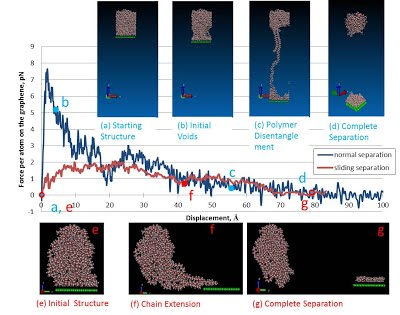Laboratory for Advanced Multiscale Materials Innovation (LAMMI) in the Department of Mechanical Engineering at Wichita State University promotes state of the art research and education related to discovery and applications of advanced engineering material systems through multiscale modeling, simulation and experiments.
Curent Research Projects:
-
Multiscale failure modeling of CNT-polymer nanocomposites
In this project, a multiscale methodology is developed for the damage analysis of the nanocomposites. A hierarchical multiscale model was developed for estimating the effective mechanical properties of a carbon nanotube (CNT)-based composite with emphasis on the effect of the interface and interface region between CNT and polymer. Cohesive zone model was implemented in the framework of micromechanics approach to bridge the atomistic modeling with the continuum mechanics in order to investigate the nanoscale interface effects on the macroscale effective mechanical properties of the nanocomposites. The macroscale effective material properties of the nanocomposites were observed to depend on the applied load, the volume fraction of CNTs, the temperature, the crosslinking rate of the thermoset polymer as well as the functionalization of the CNTs.

-
Atomistic modeling of nanoscale CNT-polymer interface effects
With the superb strength to weight ratio and the potential of multifunctionalization, the nanocomposite have been gaining increasing interesting in their application in the aerospace related structures. As one of the key factors affecting the performance of the nanocomposites, the nanoscale interfacial load transfer ability of the interface in the nanocomposites between CNTs and the polymer matrix was characterized using the all-atom models in this project, which is still extremely difficulty to explore directly in the experiments. Molecular dynamic simulations were used to study the interfacial characterizations in the CNT-reinforced nanocomposites with variable polymer matrix, thermoplastic or thermoset polymer. Parametric study is done on the influence of several parameters on the load transfer capability of the interface, such as the tortuosity of the polymer chains, the crosslinking density of the polymer network, functionalization, the environment temperature, and failure modes. Observation was made about the huge influence of functionalization, which indicates that through functionalization nanocomposites with CNT reinforcements can reach a better performance.
-
The nanoscale interface effects
Considering the scale of the CNTs is in the nanoscale, it is believed that the local atomistic interactions between the atoms in the CNTs and the polymer chains should have a great influence of the interface effects. Therefore, MD simulations are performed to characterize the nanoscale load transfer through the identification of representative nanoscale interface elements which are studied parametrically in terms of the length of the polymer chains, the number of the polymer chains and the ‘grip’ position. Once appropriate scales of these parameters are deemed to yield sufficiently converged results, the representative interface elements are subjected to normal and sliding mode simulations in order to obtain the force–separation responses at 100 and 300K for unfunctionalized CNT–PE interfaces.
Graphene-polymer interface models with variable numbers of functional groups grafted between the graphene sheet and the polymer chains are adopted to represent the interface between the CNTs and the polymer matrix. The functionalization of the graphene-PE interface is conducted by grafting the functional group between the graphene and the polymer chain through covalent carbon-carbon bonds indicated by the red rectangle in the right figure. The influence of the functionalization density on the load transfer at the interface is studied parametrically. Two force field potentials, the consistent valence force field(CVFF) and adaptive intermolecular reactive empirical bond order(AIREBO) potential, are used to simulate the interactions between the atoms in the polymer matrix and the functional groups. An energy based bond breaking criteria is introduced into the CVFF potential such that both potentials allow for bond breaking.
The normal mode force separation relations of the functionalization interface have saw-toothed shape as in the right figure, which is associated with the broken bonds observed in the MD simulations. It is noted that the peak force is increased by 15.3-21.6 times for the CVFF cases and 9.06-25.7 times for the AIREBO cases as compared to the non-functionalized graphene-PE interface model, both of which indicate an large improvements in the load transfer ability of the funcitonalized interface. Larger separation energy has also been observed for the interface with more functional groups in the normal mode separation which demonstrates higher functionlaization density can lead to the better load transfer ability of the functionalized interface.
For the sliding mode separations, 5 functional groups cases demonstrate increased overall peak force and separation energy ( 43 and 99.6 times for the modified CVFF case and 4.87 and 10.4 times for the AIREBO case). Such observations suggest that the functionalized interface model has a nearly equal load carrying capability in both normal and sliding modes, which indicates significantly improved overall load transfer ability of the interface through the functionalization. For the functionalized interface in the 10c300c cases, the strong entanglements resulting from the long polymer chains in the matrix is observed to have significant contribution on the enhanced strength of the functionalized interface, which indicates the functionalization is able to significantly improve the load transfer of the interface in the nanocomposites.

